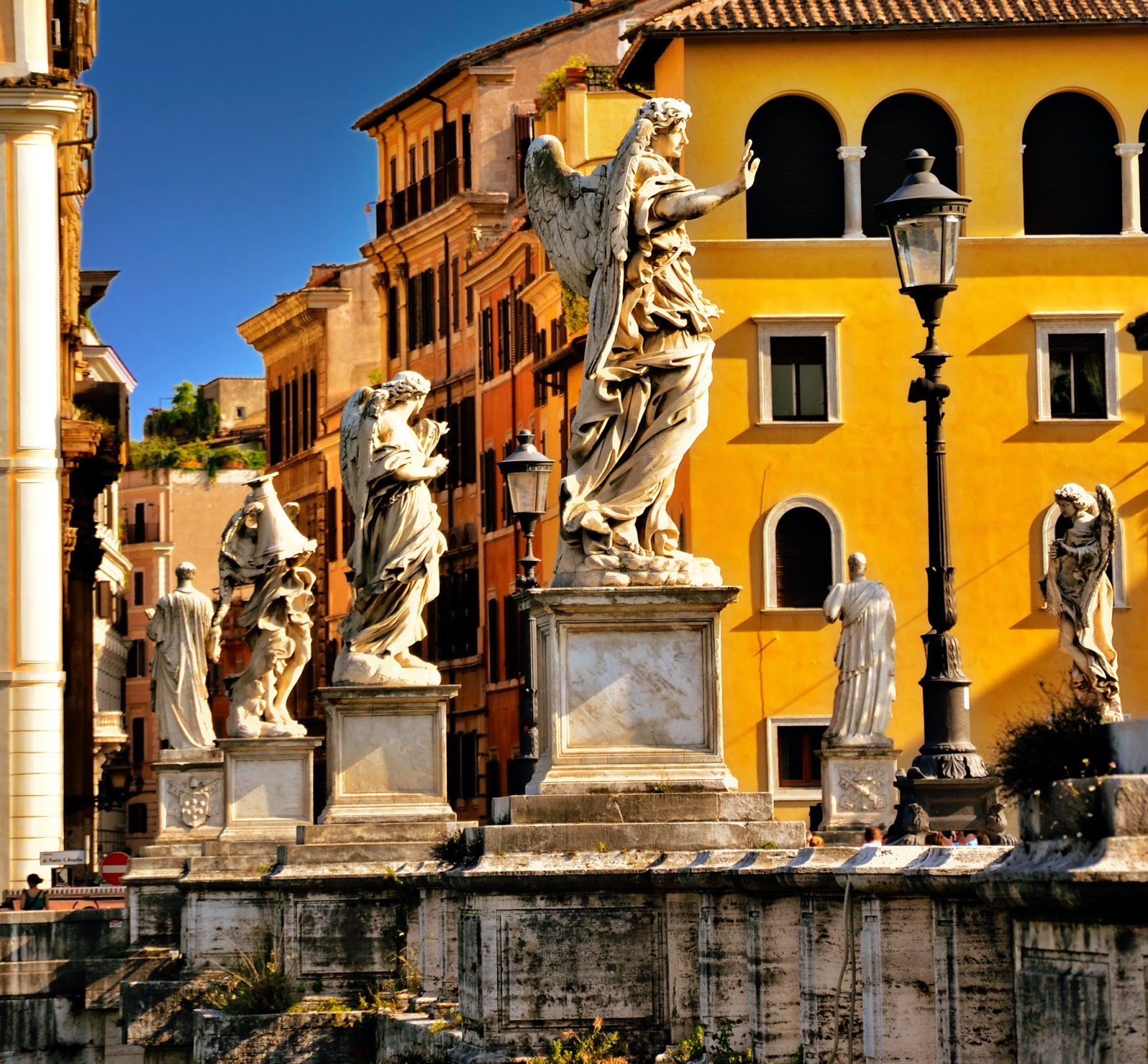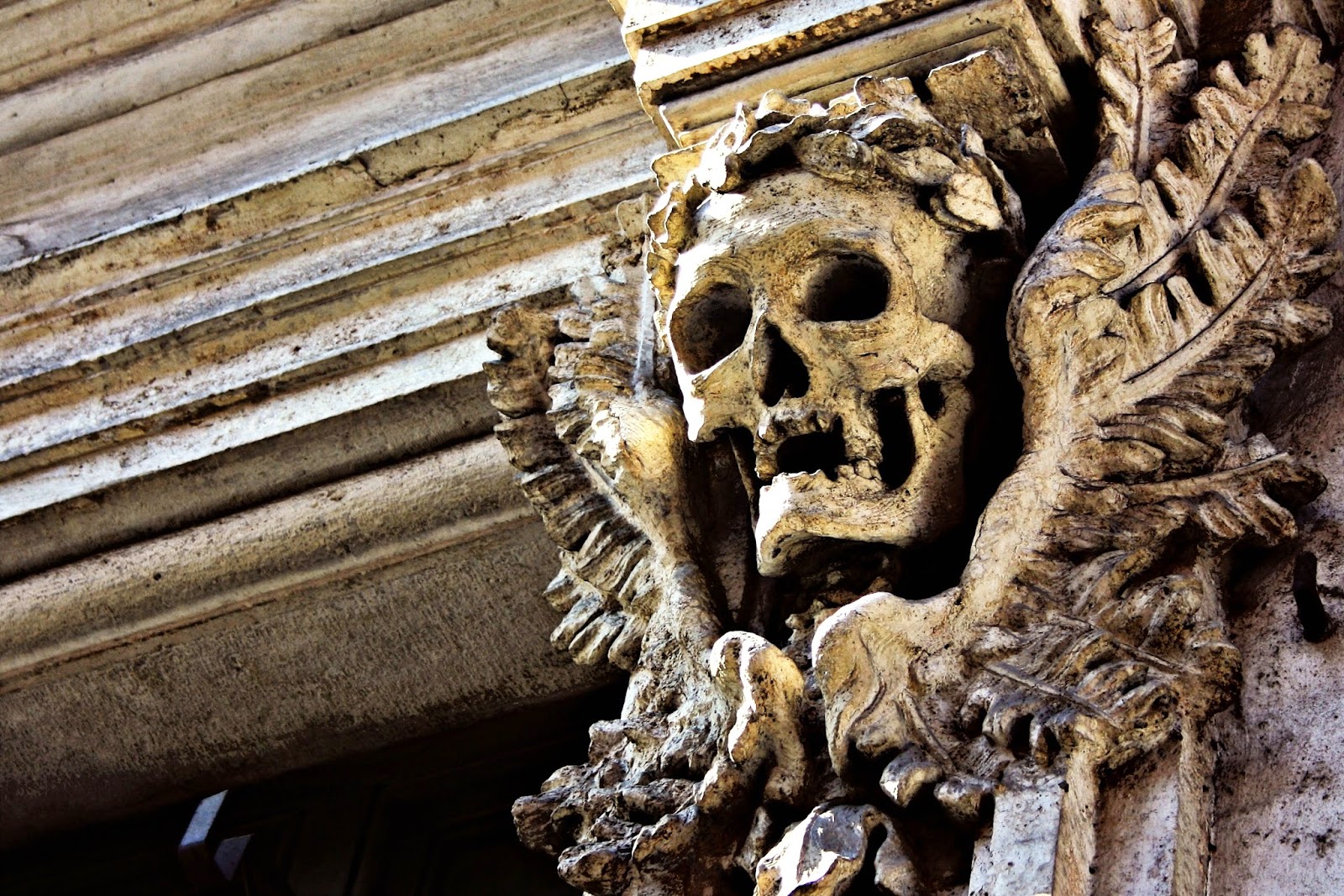10 Spookiest Places in Rome
Halloween is here! What better way to celebrate All Hallow's Eve, the night that spirits freely roam the earth, than with a tour of Rome's most sinister sites?
For lovers of the macabre, there’s no more deliciously creepy place in Rome than the Museum and Crypt of the Capuchins, where the skeletons of more than 4000 monks have been used as eerie decoration. Hipbones become moldings, chandeliers dangle with leg and arm bones, and vertebrae make intricate cornices. In the last room, over a pile of bones and three reassembled skeletons sporting the famous Capuchin hood, an ominous sign reads, “What you are we once were; what we are you will become.” Via Veneto, 27.
A tiny church in Prati has found a way to communicate with souls suffering in purgatory, and their tiny annexed museum has proof. The Museum of Souls in Purgatory displays fingerprints burned into a prayer book, a charred handprint on a wooden table, clothes marked with mysterious signs, and other creepy evidence that heaven’s unpleasant waiting room might actually exist. Lungotevere Prati, 12.
Although today Castel Sant’Angelo is a magnificent palace and a fascinating museum, it wasn’t always so. Up to the late 19th century, the dungeons of the castle were used as the papal prisons, and more often than not, once you went in, you rarely came out again, unless to mount the scaffold. Famous prisoners have included Benvenuto Cellini, Giordano Bruno, and Galileo. The bridge right outside, with its copies of Bernini angels, may look uplifting, but it was here that countless public executions took place, including the infamous decapitation of 22-year-old Beatrice Cenci in 1599. Her ghost is said to walk the bridge every September 11th, the anniversary of her death, with her severed head in her hand. The bridge was also the site of a stampede during the Jubilee of 1450, when more than 200 people were trampled to death or drowned. Lungotevere Castello, 50.
In Renaissance Rome, murder was practically considered a sport, and bodies floating in the Tiber were far from rare. From its convenient position just a few steps from the riverbanks, the church of Santa Maria dell’Orazione e Morte would fish the bodies out of the river, stack them in the cellar, and bury any that went unclaimed. The church is decorated with ghoulish images and boasts a cross made of skulls. A chilling sign on the door reads, “Today for me, tomorrow for you.” Via Giulia, 262.
St. Peter’s Basilica has five sets of Bronze Doors, the most noted being the Holy Doors (open only on occasion of a Holy Year) and the massive central Filarete doors, the only set original to the Constantine Basilica. Less well-known, but no less intriguing are the Doors of Death, to the far left of the portico, used as the exit for funeral processions. Cast in the 1960s by Giacomo Manzù, the doors feature morbid scenes of crucifixions, hangings, and other martyrdoms, as well as the heads of vultures looking out ominously. When I used to give tours of St. Peter's basilica, I refused to walk through these ones, even though they are one of the two main exits. Piazza San Pietro.
If you find torture even creepier than death (and let's face it, who doesn't?), make a timely visit to Rome's Museum of Criminology. Learn about medieval torture techniques and see many of the gruesome devices used to elicit "confessions". Perhaps the most disturbing thing about this place is realizing some of these torture techniques were used until the 20th century. This museum is not for the faint of heart, especially if you've got a good imagination. Via del Gonfalone, 29.
If the image of an old abandoned hospital or insane asylum conjures up your worst nightmares, this is the place for you! Even the name of it is enough to make a grown man squirm. The National Museum of Sanitary Art is one place that will make you glad to be living (and getting sick) in the 21st century. Located in a wing of a hospital founded in the 1400s, this museum displays such unappetizing objects as pickled fetuses, child skeletons, and many many more atrocious items. Lungotevere in Sassia.
Miles and miles of dimly lit, underground burial chambers? I think that would qualify as spooky. Perhaps the most terrifying thing about the Catacombs (besides the fact that thousands of souls were buried here, some of whom suffered horrifically violent deaths) is knowing that one wrong turn could lead you into utter darkness and you could easily end up lost for days in the maze of narrow death-soaked passageways, as happened to a few French kids in the Paris catacombs a few years ago. There are many (some say upwards of 40) Catacomb sites in Rome. The most popular is probably The Catacombs of San Callisto. Via Appia Antica, 110.
As the site of the brutal deaths of an estimated 700,000 people, is it any wonder the Colosseum is considered one of the most haunted places in the world? In the Middle Ages it was believed to be a gathering place for souls at unrest, and as late as the early 20th century, it was thought that the noxious fumes of the countless murders that took place here could be fatal to anyone who breathed them, particularly at night. Such was the fate of Henry James’ heroine Daisy Miller, whose nighttime visit to the Colosseum proved fatal.
Although it is a cemetery, I'm not sure this site can really be described as spooky. In fact, it could just as easily be included in a list of the 10 Most Beautiful Places in Rome. Dubbed by Oscar Wilde “the holiest place in Rome,” the exquisite Non-Catholic Cemetery is reserved for Rome’s Protestant, Orthodox, Jewish, and otherwise non-Christian dead, and is famously the resting place of John Keats, Percy Bysshe Shelley, and Goethe’s only son. With its view of the ancient Pyramid of Cestius, towering cypress trees, and tombstones and mausoleums that are veritable works of art, this might just be the most enchanting cemetery in the world. Via Caio Cestio, 6.


![Crypt of the Capuchin Monks, Santa Maria della Concezione [source]](https://images.squarespace-cdn.com/content/v1/58ca6ce9a5790a218472236e/1490278340196-8ANKTGLOJASV0NQZZPIB/c530d-crypt2bof2bthe2bcapuchins2b1.jpg)
![Fingerprints burned onto a prayer book, Museo delle Anime in Purgatorio [source]](https://images.squarespace-cdn.com/content/v1/58ca6ce9a5790a218472236e/1490278341878-2FPDEO24JSGEZ0KSB0RO/fa4c0-thumbnail.jpg)
![Handprint burned onto wood, Museo delle Anime in Purgatorio [source]](https://images.squarespace-cdn.com/content/v1/58ca6ce9a5790a218472236e/1490278340792-QC5V3BLZ9OCEG61Q8WLV/d1fbf-1.jpg)
![Passageway leading to the dungeons of Castel Sant'Angelo [source]](https://images.squarespace-cdn.com/content/v1/58ca6ce9a5790a218472236e/1490278338211-SL8S480MXXMQOS9OMYO4/80b46-tumblr_m3sg7adefi1qa1ulo.jpg)




![Left "Door of Death," Giacomo Manzù [ìsource]](https://images.squarespace-cdn.com/content/v1/58ca6ce9a5790a218472236e/1490278334681-FS0X8HSSG14R39M50GGQ/1cfbf-basilica2bs-2bpietro2bdsc_8693.jpg)
![Detail of "Doors of Death," Giacomo Manzù [source]](https://images.squarespace-cdn.com/content/v1/58ca6ce9a5790a218472236e/1490278333520-YDPIW88INTWGJPZRTTH4/0b43a-porta-della-morte-vaticano-1952-64.jpg)
![Screw chair (reproduction), Museo di Criminologia, Rome [source]](https://images.squarespace-cdn.com/content/v1/58ca6ce9a5790a218472236e/1490278336527-7BTQMQRWBX1B3VZY4JLW/476fc-07.jpg)
![Female skeleton discovered shacked in Poggio Catino in the 1930s, Museo di Criminologia, Rome. [source]](https://images.squarespace-cdn.com/content/v1/58ca6ce9a5790a218472236e/1490278337533-SETOVIG2QVWW2GQ0CIY8/73dca-18.jpg)
![Human-shaped cage, discovered with real skeleton, Museo di Criminologia, Rome [source]](https://images.squarespace-cdn.com/content/v1/58ca6ce9a5790a218472236e/1490278340717-5YSOA865CZVC9FUL70WH/cb15d-20a.jpg)
![Exhibit at Museo dell'Arte Sanitaria, Rome [source]](https://images.squarespace-cdn.com/content/v1/58ca6ce9a5790a218472236e/1490278338681-P638FYPR5XWUNH9ARZTM/9b278-20130222_114458.jpg)
![Exhibit of child skeletons, Museo dell'Arte Sanitaria, Roma [source]](https://images.squarespace-cdn.com/content/v1/58ca6ce9a5790a218472236e/1490278335301-A1PGE2CXQ0MUN03XYG7A/2b757-img_3233.jpg)
![Catacombs of San Callisto, Rome [source]](https://images.squarespace-cdn.com/content/v1/58ca6ce9a5790a218472236e/1490278336680-K8AW59K0B0Y0GH1J9HD2/52e50-10572968.jpg)
![Catacombs of San Callisto, Rome [source]](https://images.squarespace-cdn.com/content/v1/58ca6ce9a5790a218472236e/1490278333599-OVC5L4TRDJWDJ8RPVB1Z/17305-5706609-san_callisto_catacombs-0.jpg)
![Colosseum by Night [source]](https://images.squarespace-cdn.com/content/v1/58ca6ce9a5790a218472236e/1490278341092-KKIF74VRYI7KAGTGXCN8/da942-colosseum_at_night_-_wide_angle.jpg)

